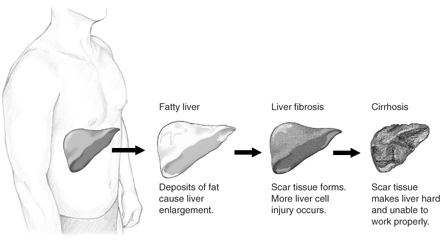
True

What Is It?
NAFLD and NASH:
Up to 25 percent of people in the United States are affected by nonalcoholic fatty liver disease (NAFLD), which is characterized by accumulation of fat in the liver that is not attributed to alcohol. Approximately one-third of NAFLD patients will develop nonalcoholic steatohepatitis (NASH), a severe form of NAFLD with inflammation that is associated with increased risk for liver cirrhosis, end-stage liver disease and primary liver cancer. More than 10 percent of adults may be living with NASH.
Nonalcoholic fatty liver disease (NAFLD)
Nonalcoholic fatty liver disease (NAFLD) is most typically seen in individuals who are overweight or obese or have diabetes, high cholesterol or high triglycerides. As NAFLD progresses, the excessive fat accumulation (steatosis) can cause inflammation (steatohepatitis) and may lead to progressive fibrosis and cirrhosis, liver failure, primary liver cancer (hepatocellular carcinoma) and even death.
If NAFLD progresses to nonalcoholic steatohepatitis (NASH), this signals more pronounced liver damage. NASH is often called a "silent" liver disease, because people with NASH may feel well, allowing the disease to progress for years, or even decades, without diagnosis.
NASH is believed to be one of the most common chronic liver diseases worldwide. There is an estimated prevalence of more than 10 percent of the general adult population in the United States.
Most people with NASH are between 40 and 60 years old, though the disease is being seen more in adolescents as our population becomes more overweight and obese. NASH is more common in women than in men.
It has become the second most-common reason for liver transplant in the United States and is projected to become the leading reason for transplant in the next few years, overtaking hepatitis C.
NASH can also cause primary liver cancer. In up to 40 percent of the primary liver cancer cases that develop in people with NASH, the cancer occurs before they develop cirrhosis.
In the advanced stages of NAFLD or NASH, as the liver fibrosis worsens and the liver becomes cirrhotic, symptoms may include fatigue, muscle weight loss, weakness, jaundice, confusion, swelling of the legs or fluid in the abdominal cavity. Life-threatening bleeding from the intestines can occur. Over time, this progresses to liver failure.
Liver transplantation is the only treatment available to patients with liver failure due to NASH-related cirrhosis. There are currently no medications approved for treating NASH though a few medications are in clinical trials, evaluating their roles to treat NASH.
Nonalcoholic steatohepatitis (NASH)
Nonalcoholic steatohepatitis (NASH) is projected to become one of the most serious public health challenges of the 21st century. Despite its growing prevalence, there are currently no approved treatments for the condition. Consider these numbers:
This resource was created with the support of Intercept Pharmaceuticals.
Nonalcoholic steatohepatitis (NASH) is believed to be one of the most common chronic liver diseases worldwide, affecting an estimated more than 10 percent of the general adult population in the United States.
NASH is usually first suspected in someone whose blood test indicates elevated liver enzymes, such as alanine aminotransferase (ALT) or aspartate aminotransferase (AST). A liver biopsy is required to confirm a NASH diagnosis.
Patients generally feel well in the early stages and only begin to have symptoms—such as fatigue, weight loss and weakness—once the disease is more advanced or cirrhosis develops.
The progression of NASH can take years, even decades. The process can stop and, in some cases, reverse on its own without specific therapy. NASH can also slowly worsen, causing scarring or "fibrosis" of the liver tissue. As fibrosis worsens, cirrhosis develops; the liver becomes seriously scarred, hardened and unable to function normally.
Not everyone with NASH develops cirrhosis, but once serious scarring or cirrhosis occurs, there are no treatments that can reverse the cirrhosis. A person with end stage cirrhosis experiences fluid retention, muscle wasting, confusion (encepalopathy), bleeding from the intestines, jaundice and eventually liver failure. Liver transplantation is the only treatment for advanced cirrhosis with liver failure, and transplantation is increasingly being performed in people with NASH.
No single test can diagnose NASH. Your health care provider will ask you about other health problems you've had. To see if fat is building up in your liver and to rule out other diseases, your health care provider may do tests such as:

This resource was created with the support of Intercept Pharmaceuticals.
Currently, no specific therapies for nonalcoholic steatohepatitis (NASH) exist. The most important recommendations given to people with this disease are to:
Once a person has developed liver failure from NASH, liver transplantation is the only available treatment. In the United States, the proportion of liver transplants attributable to NASH has increased rapidly in past years, and by 2020 the disease is projected to become the leading reason for liver transplant, ahead of chronic hepatitis C and alcoholic liver disease.
This resource was created with the support of Intercept Pharmaceuticals.
Although nonalcoholic steatohepatitis (NASH) has become more common, its underlying cause is still not clear. It most often occurs in people who are middle-aged and overweight or obese. Many people with NASH have elevated blood lipids, such as cholesterol and triglycerides, and many have diabetes or prediabetes, but not every obese person or everyone with diabetes has NASH.
Furthermore, some people with NASH are not obese, do not have diabetes and have normal blood cholesterol and lipids. NASH can occur without any apparent risk factors and can even occur in children. Thus, NASH is not simply obesity that affects the liver.
While the underlying reason for the liver injury that causes NASH is not known, several factors are possible candidates:
NASH ranks as one of the major causes of cirrhosis in America, behind hepatitis C and alcoholic liver disease, according to the National Institute of Diabetes and Digestive and Kidney Diseases.
This resource was created with the support of Intercept Pharmaceuticals.
This resource was created with the support of Intercept Pharmaceuticals.
Having a list of questions to ask a health care provider during an appointment can help you remember your important concerns. Be sure to bring these questions (and any others you may add) and a pen to write down the answers.
1. What is causing fat to build up in my liver?
2. Do I need to lose weight? If so, what percentage of my current body weight do I need to lose?
3. How can I safely lose weight?
4. What diet changes do I need to make if any?
5. Should I change my current physical activity level because of my condition?
6. What lifestyle changes do I need to make, if any?
7. Is it possible to reverse nonalcoholic steatohepatitis (NASH) in my case?
8. What can I do to slow down the progression of NASH?
9. What are symptoms to pay attention to and look out for?
10. How can I manage the symptoms?
11. Will there be pain? Can it be controlled?
12. What symptoms may occur that could require immediate attention?
13. What medications or other substances should I avoid?
14. How will you assess whether the NASH management or treatment is working for me?
15. How often should I see my primary care physician or a liver specialist?
This resource was created with the support of Intercept Pharmaceuticals.
The more severe form of nonalcoholic fatty liver disease (NAFLD) is called nonalcoholic steatohepatitis (NASH). NASH causes the liver to swell and may lead to liver scarring. NASH tends to develop in people who are overweight or obese, or have diabetes, high cholesterol or high triglycerides. However, some people have NASH even if they do not have any risk factors. Most people with NASH are between 40 and 60 years old. NASH is more common in women than in men. NASH often has no symptoms, and people can have NASH for years before symptoms occur. NASH is one of the leading causes of cirrhosis in adults in the United States. Up to 25 percent of adults with NASH may develop cirrhosis, according to the American Liver Foundation.
NASH is usually first suspected in a person who is found to elevated liver enzymes in tests that are included in routine blood test panels, such as alanine aminotransferase (ALT) or aspartate aminotransferase (AST). A liver biopsy is required to confirm a NASH diagnosis.
You can take steps to keep yourself healthy. Talk to your health care provider about treatment options and diet recommendations.
No, NASH is not contagious and cannot be spread from one person to another.
Yes, people with NASH can continue to work and do everyday activities.
NASH causes the liver to swell and a swollen liver may cause scarring (cirrhosis) over time and may even lead to liver cancer or liver failure.
Family members can take the following steps to reduce their risk of NASH:
HealthyWomen content is for informational purposes only. Please consult your healthcare provider for medical advice, diagnosis or treatment.